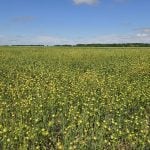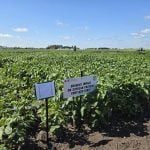Tag Archives seed treatment

Seed treatment targets flax stands
Researchers are investigating whether seed treatment products can improve crop emergence and plant stands

Carberry field day looks for agriculture solutions
Manitoba farmers explore research solutions for resilient crops, agronomic issues and new kinds of ag products

Chemical delays aggravate Aussie farmers

Seed treatment offers dual pest protection
Corteva’s latest fungicide covers disease and insects such as airborne blackleg, cutworms and flea beetles
A new active ingredient called Lumiscend that Corteva Agriscience offers in its LumiGEN fungicide package protects canola from blackleg fungus including its airborne spores. Seed treatments that prevent blackleg-contaminated canola seed from starting an infection have been around for a long time but they offered no protection to seedlings that get infected in the field. […] Read more
Seed treatments need to work — all the time
Putting tiny amounts of active ingredients over millions of seeds in every run evenly and reliably is a challenge
STANTON, Minn. — You’ve got the genetics, now how do you take full advantage of them. Most producers in Western Canada plant seed with applied treatments, fungicide and insecticide. Virtually all canola is treated. As well, in areas where soybeans and corn are the norm, all seed is treated, as it is in many small-cereal […] Read more
Taking seed treatments on the road
New product – seed treatment

Neonics: better alternatives or only option?
Entomologists claim there are less toxic products available; researchers say depending on the pest, alternative treatments are more hazardous
Many growers, crop protection companies and agronomists use a standard line to defend insecticide seed treatments. The line goes something like this: if neonicotinoid seed treatments were banned, growers would control pests with older insecticides like organophosphates, which are more toxic to bees, wildlife and humans. Jean-Marc Bonmatin, of the National Centre for Scientific Research […] Read more
Give seed the treatment it deserves

Will Ont. neonic crackdown spread West?
Prairie farmers urged to take note | Farmers in Ontario will have to take a management course and justify neonic use
An Ontario canola grower says western Canadian farmers shouldn’t ignore new seed treatment regulations in his province because the decision to cut neonicotinoid use by 80 percent will affect farmers across the country. The Ontario government unveiled proposed regulations last week to curtail the use of neonicotinoids on corn and soybean seeds. Starting in 2016, […] Read more




